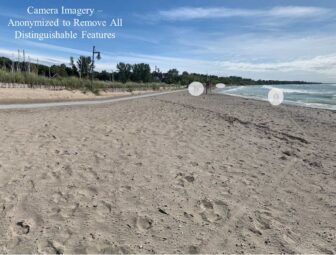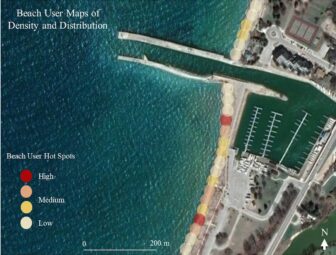
Cameras capture still images identifying where people enter, exit or gather on the beach. Image: Dana Van Allen
By Jack Armstrong
A system of beachside cameras developed by the University of Windsor could prevent drownings by tracking beachgoer behavior.
Researchers are now analyzing data collected this summer for the Smart Beach project. The idea is to better understand human behavior in a way that prevents hazardous situations, said Chris Houser, the lead researcher and the university’s dean of science.
“A large part of our research for the last 10 plus years has actually been focused on the physical and social dimensions of beach safety issues,” Houser said. The idea is to understand when and where rip currents form and whether people understand the danger they represent.
The cameras take still images every 20 minutes between 6 a.m. to 7 p.m. and identify wave and human activity, giving researchers a better idea of where and when people are using different parts of the beach. They will use this information to design warning systems to help protect beachgoers from rough water.
“If the waves are really, really big, people tend not to get into the water because they see it as dangerous,” Houser said. “But if waves are kind of moderate, you might still have a rip current, you might still have hazardous conditions for somebody. The question is, at what level do people get into the water? And where do they get into the water under those kind of moderate hazard conditions?”
Solutions could be installing warning signs at particular spots on the beach, or shifting boardwalks and beach entrance points away from dangerous areas.
“It’s about creating design nudges that kind of improves beach safety by forcing people’s behavior,” Houser said. “But in order to do that, we need to know where they are, how they’re using the beach.”
The cameras can’t recognize people or faces, but they can recognize a human body – an “individual blob,” Houser said. They map each blob relative to the length and width of the beach. And they can identify where people usually access the beach, enter the water and cluster in groups.
Knowing where rip currents form is useful, but understanding safety threats stem from understanding how people interact with that current, Houser said. This data would help researchers create more dynamic and informed warning systems.
University of Windsor undergraduate student Ben Chittle built the cameras from scratch.
“We had a commercial alternative, which we couldn’t get in time, so we had to essentially build our own,” Chittle said.
The cameras run on Raspberry Pi computers, credit-card-sized circuit boards that can be programmed to perform custom functions.
“They’re not very powerful, but they can certainly handle the job,” Chittle said. The solar-powered cameras rely on a backup battery under cloudy conditions. Researchers have downloaded the data a few times and are happy with the results, Chittle said. The long-term goal is to have remote access to the data in real time to determine the safety conditions of the beach at any given moment.
Houser partnered with the Kincardine Municipal Innovation Council in Ontario this summer to run a Smart Beach pilot on Station Beach, an increasingly popular Lake Huron beach. Kincardine is about 140 miles northwest of Toronto.

A system of cameras at Station Beach in Kincardine, Ontario could help researchers design warning systems that target areas of higher danger.
“We’re really trying to improve water safety,” said Becky Smith, leader of the innovation council. “We’ve got the opportunity to use a first of its kind project to ensure that our beaches remain a safe place to swim and enjoy and surf, too.”
The three-year project was launched last May along with a public awareness campaign about potential hazardous water conditions. The first year focused on data collection and public education, Smith said. The goal next year is to identify the appropriate communication tool to increase safety.
Only one person has raised privacy concerns about the cameras, said Dana Van Allen, director of communications at the Nuclear Innovation Institute, a non-profit organization providing support for the Smart Beach Project.
“Personal privacy around public spaces is critical, so protecting the privacy of beach users was a fundamental principle of the Smart Beach project from the beginning,” Van Allen wrote via email. “Information about the cameras has been communicated through press releases, social media, the SmartBeach.ca website, and signage at the beach access point, which informed users that cameras were in operation.”
Smith said the program could also help first responders.
“We see time and time again, our local fire departments are being deployed out to where there’s been rough water, and so making sure that they have accurate information about the water conditions will also help them,” Smith said.